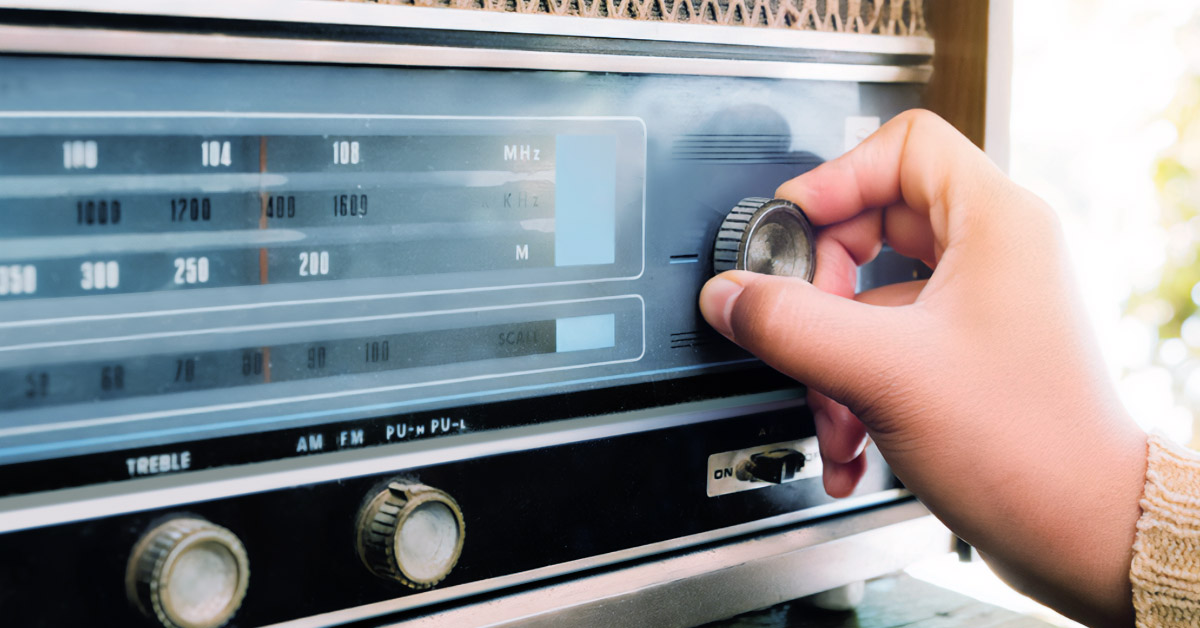
August 20, 2024
Celebrating the Evolution of Radio: From Invention to Advertising
With National Radio Day on August 20 and Radio Commercials Day on August 28, this is the perfect time to reflect on the profound impact radio continues to have on our world, on our communities, and on our lives. A full 92% of Americans listen to radio, with adults averaging 104 minutes of listening per day – that’s 12.2 hours every week. The shared experience of tuning in to our favorite stations and programs is a testament to radio’s universal appeal.
From its origins in the early 20th century to its enduring power to entertain and inform, radio remains a powerful medium, demonstrating an unwavering commitment to connect and support our communities. A closer look at the history of radio and the evolution of radio commercials highlights their profound significance in our lives.
The Birth of Radio: A Communications Revolution
Radio took the world by storm at the dawn of the 20th century. Italian inventor Guglielmo Marconi is credited with building the first practical radio communication system, transmitting the first radio signal across a distance of 1.5 miles in 1895. His work culminated in the first successful transatlantic radio transmission in 1901, which proved the potential of radio as a means of long-distance communication.
Radio technology rapidly advanced over the next 20 years. Its first applications were primarily practical, providing military, public service, and emergency communications, including the broadcast of the Titanic’s distress signal in 1912. By the 1920s, radio had become a household fixture, bringing news, music, and entertainment into homes worldwide. The first commercial radio station, KDKA in Pittsburgh, Pennsylvania, began broadcasting in 1920, marking the beginning of radio as a mass medium. Radio soon became the dominant form of home entertainment, with families gathering around their sets to listen to everything from live music performances to news broadcasts to radio dramas.
The Rise of Radio Commercials: A New Era in Advertising
The concept of radio advertising was born out of the need to monetize the growing medium, creating the opportunity for businesses to reach large audiences. The first radio commercial aired on August 28, 1922, on New York station WEAF. The advertisement, which promoted the services of the Queensboro Corporation, a real estate company, lasted ten minutes and cost $50 to air. This historic event marked the birth of radio commercials and set the stage for the evolution of broadcast advertising.
Radio commercials quickly became a popular and effective way for businesses to reach consumers. The format allowed advertisers to deliver their messages directly to listeners in the comfort of their homes. Unlike print advertisements, radio commercials gave advertisers the ability to convey emotion and personality through voice and music, making them more engaging and memorable.
Radio commercials reached new heights during the 1930s and 1940s, known as the Golden Age of Radio. Sponsored radio programs became the norm, with advertisers creating entire shows around their products, often naming them after their brands. Popular radio programs like The Jell-O Program, The Chase and Sanborn Hour, The Pepsodent Show, and The Lucky Strike Program – (it was a different time) – seamlessly integrated commercials into the content. This era also saw the rise of jingles, catchy musical ads that remain a staple of radio advertising today.
The Impact of Radio Commercials on Culture
Radio commercials not only influenced consumer behavior but also played a role in shaping culture. During World War II, radio commercials were used to promote war bonds, recruit soldiers, and encourage resource conservation. These ads were crucial in mobilizing the home front and contributed to the war effort, demonstrating the power of radio commercials to influence and shape societal norms.
Radio continued to evolve after the war, but the advent of television in the 1950s began to overshadow radio as the dominant medium. Radio commercials, however, remained highly relevant and effective, particularly in reaching niche and local audiences. With its superior sound quality, the rise of FM radio in the 1960s and 1970s gave radio commercials a further boost, especially for music-oriented content.
Radio commercials have not only survived but thrived in the face of changing technologies and consumer behaviors. In the 1980s and 1990s, radio ads became shorter and more targeted, reflecting the fast-paced nature of modern life. Digital radio and streaming services in the 21st century have further transformed radio advertising, allowing for more personalized and interactive ads. Despite these changes, the core appeal of radio commercials – engaging the listener through voice and sound – remains as strong as ever.
The Enduring Legacy of Radio and Radio Commercials
As we celebrate National Radio Day and Radio Commercials Day, it’s clear that radio has left an indelible mark on our society. From its early days as a groundbreaking communications tool to its role in shaping modern advertising, radio has been a constant presence in our lives. Radio continues to thrive even in the digital age, with millions of people tuning in daily for news, music, and entertainment.
Radio commercials, too, have stood the test of time. While the format and delivery methods have evolved, the essence of radio advertising remains unchanged – connecting with listeners in a personal and memorable way. Whether through a catchy jingle, a heartfelt message, or a humorous skit, radio commercials have the power to engage, entertain, and inform, creating a unique connection with each listener.
Whether you’re a fan of classic radio dramas, a lover of music, or an advertiser looking to connect with your audience, radio has something for everyone. Here’s to many more years of tuning in and turning up the volume on the radio!
WideOrbit loves radio! Check out these past blog posts celebrating radio.
- Celebrating National Radio Day and Radio Commercials Day
- Happy 100th Anniversary to Radio: Love Letters Celebrating History, Connection, and Community
